Bowl toilet bowl, which design is most convenient
Toilets are sanitary appliances, without which you can not imagine a modern home. They greatly improve sanitary hygiene in the administration of natural needs. When choosing a device, it is necessary to take into account that it is comfortable, easy to clean and not splash. The last task is best solved visor bowl toilet bowl.
Let us examine some important aspects that affect the choice of instrument.

Sewage release
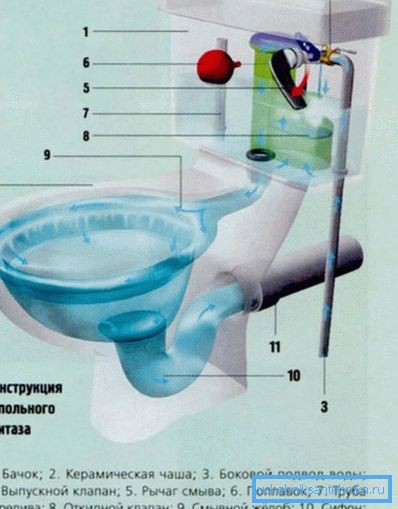
Before purchasing a device, find out where the toilet is located in the toilet and goes to the sewer pipes.
This release can be of two types: vertical straight (hole in the floor) or horizontal (hole in the wall).
On this basis, and toilet bowls according to the method of release and the location of the taps, are divided into the following products:
- with horizontal outlet;
- with vertical outlet;
- with an oblique or oblique release (it is located at 30/45 ° relative to the floor plane).
All of these species have their own characteristics.
- Vertical discharge mates with sewer riser coming out of the floor. This is not very convenient, however, it provides advanced features for planning the toilet or bathroom. For example, it allows you to put the toilet at a minimum distance from the wall, it saves the size of the bathroom. Or vice versa, move the device to the middle of the room.
- The most practical sloping toilet outlet exit. It mates with the pipes of the riser at angles from 30 degrees to 45.
- Horizontal analog must be flush with the vertical riser hole located in the wall.
Note! The last two types of releases make it possible, using transition pipes (including flexible ones), to connect the device to the riser, regardless of its location. Such sinks can have both mounted and floor models of toilet bowls.
Drain system
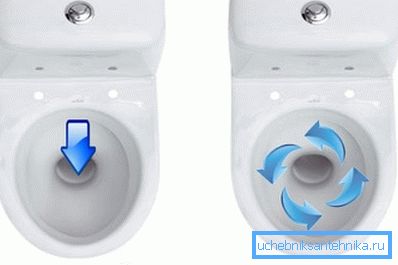
The instruction notes that the fundamentally flushing system of the device is important.
Its effectiveness depends on the method of supplying water to the cup of the device and the type of its discharge.
- With a direct (or so-called horizontal, cascade) water supply, its continuous flow pours powerfully into the bowl from one point and causes 2 very noticeable hydraulic impacts. They are aimed at feces, as well as the wall of the cup opposite to the accumulating tank. The result - a lot of spray and noise, but the surface of the bowl is not fully cleaned. On this basis, the user increases the pressure, which leads to high costs of water, and the toilet bowl has to be washed longer.
- At the moment, the reverse (per capita or circular) method is more common. With it, water flows around the entire circumference of the cup. When fed through the half-open channels, it changes the direction of movement to the opposite. This creates a more uniform flush. Further, the water forms a suction funnel, all waste products enter it.
Due to the vertical type of flushing the walls, bowls are cleaned better, but water is spent less. Such a device is inherent only in floor toilets without a ceramic shelf.
The design of the toilet bowl

Having correctly picked up the sanitary device according to the shape of its bowl, you will be relieved of a rather unpleasant problem, namely, splashing when using the device.
The types of toilet bowls are presented below.
Toilet bowls
This design is already outdated. At the back of the cup of such devices there is a ledge (shelf) in the form of a plate. Despite the fact that these models are not in demand, they can still be found in the ranges of foreign and our manufacturers.
The main advantage of this design is the absence of a water splash.
However, such models of toilet bowls have many drawbacks.
- In the toilet there are reinforced sewer odors, even after the feces have already been washed away.
- On the ledge stick residues of vital activity. They have to constantly clean with the brush.
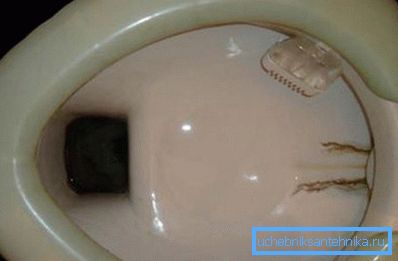
- When flushing on the shelf there is water. This over time causes the deposition of lime and the appearance of rusty stains, they are formed along the edges of the protrusion.
- In addition, the toilet with the shelf in the bowl waste water economically.
Analogs visor (with a slope)

Such devices have a slope in the bowl. It can be in different models directed both from the front wall and from the back. In both variants, there is almost no spray. However, a toilet brush is sometimes necessary to use.
Note! Visor type bowls are the most hygienic. They guarantee a minimum amount of unpleasant odors.
Funnel Bowls
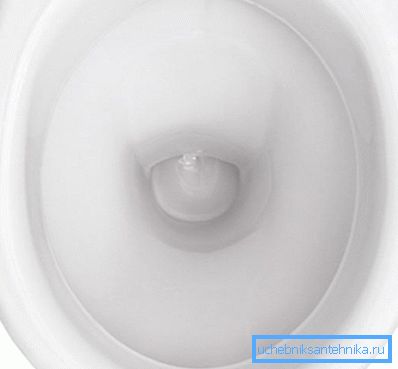
Thinking about which shape of the toilet bowl is better, pay attention to the funnel-shaped counterparts.
- They are hygienic, because the brush is only necessary in extreme cases.
- Such toilet bowls are economical in water costs.
- The formation of sewage odors is minimal.
However, such a device has one, but a significant disadvantage - a large number of splashes. On this basis, many manufacturers equip their funnel-shaped instruments with the Anti Splash system.
The principle of the device: the less water in the water seal (usually, the water level in it is about 7 cm), the smaller the spray. Manufacturers of sanitary devices are constantly changing their geometry. The meaning of the improvements is that the spray does not reach the user.
Anti Splash System
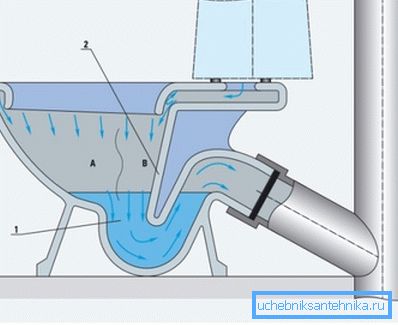
At the moment, almost all models of toilet bowls, the price of which is quite high, have a similar system in their characteristics.
However, here it should be borne in mind that this may be just a statement of the manufacturer and not be true.
Note! If you want to install your own device with the function "Anti surge", then you should know that such a device is a bowl. Before purchasing a toilet bowl, you should check the following.
- With such a system, the bowl has a special geometry of its drain hole: it is narrowed to a minimum, flushed downwards and shifted in a certain direction.
- Another main feature - the water column (water seal) in the bowl drain is at a low level (7 cm).
- In addition, a protruding rim should be located along the contour of the drain hole.
If the bowl has all these features, then it is really equipped with the Anti Splash system.
Conclusion
Modern toilets have a different structure of the bowl. All its varieties have their own advantages and disadvantages. Choose a sanitary appliance, based on what features are most important to you. The video in this article will develop its theme.